Onion
Introduction
The onion also known as the bulb onion or common onion, is an annual vegetable that is widely cultivated in Kenya. It has bluish-green leaves and its bulb at the base of the plant begins to swell when a certain number of days in the growing cycle is reached. The bulbs are either red, yellow or purple. Onions contribute savory flavor to dishes without contributing significant caloric content.
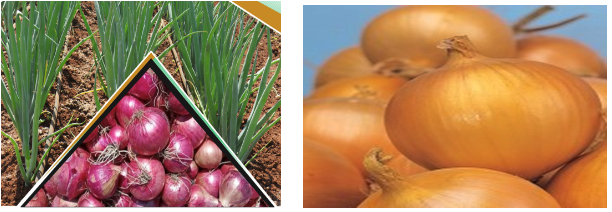
How to Grow
Varieties
1.Red Creole
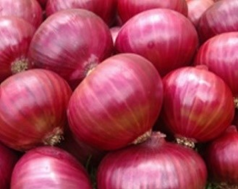
- Maturity150 days after transplanting.
- Medium to large bulbs.
- Yields 40,000 kg per ha.
- Long shelf life.
- Pungent taste.
- Excellent in storage.
- Matures in 80-90 days from transplanting.
- Flattened globe shape bulb onion.
2. Red Couch F1

- Produces medium to large dark red bulbs.
- Yields 25-30 tons per ha.
3. Jambar F1
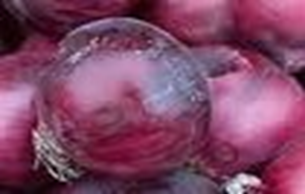
- Matures after 90-120 days.
- Medium to large bulbs.
- Yields 23,000 kgs bulb per ha.
- Long shelf life (4-6 months).
4. Bombay Red
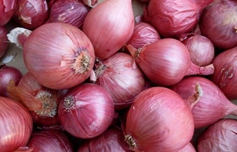
- Variety for dry and warmer conditions.
- Produces small to medium sized bulbs.
- Deep purple red color and very pungent.
- Maturity 150 days from transplanting.
- Yields 40 tons per ha.
5. Texas Early Grano
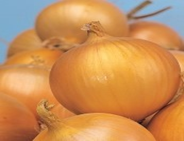
- Does not store well.
- It has mild pungency which is good for salad.
- Yields 50 tons per ha.
6.Neptune F1
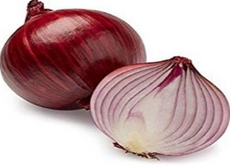
- High yielding.
- Firm shinning red bulbs.
- Good pungency.
- Good for salads, red-skin.
- Mid-late maturing (110 -120 days).
- Storage period (5-6 months).
- Pink root resistant.
7. Red Pinoy

source:Agroduka.com
- Deep red attractive bulbs.
- Matures in 90 days from transplanting.
- Strong pungency.
- Long shelf life of up to 6 months.
- Tolerant to downy mildew and purple blotch.
- Yields 75 tons per ha.
8. Red Passion F1

- Deep red.
- Matures in 120 days.
- Stores up to 5 months.
- Tolerant to pink rot and purple blotch.
- Yields 50 tons per ha.
9. Red Nice F1
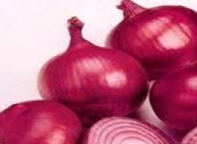
- Matures in 150 days.
- Six months storability.
- Yields 62 tons per ha.
- Tolerant topurple blotch disease.
10. Red Star F1

Source:
https://web.facebook.com/easeedmarketing/posts/2660176707411380/
- Matures in 120-140 days after transplanting.
- Yields 62-75 tons per ha.
- Dark red bulbs.
Select a site for onion production with:
- Well-drained soil, rich in organic matter and sufficient moisture and pH of 6.0 – 6.8.
Ecological Requirements
- Onion grow best al altitude below 1900 m.a.s.l.
- Temperature: 12 – 23oC is required for optimal growth.
- Rainfall: A well-distributed rainfall of between 500 – 700 mm.
- Till the land before planting and before onset of rain.
- Land preparation during wet-period prevent unintended spread of soil borne diseases and compaction.
- It is advisable to carry out soil analysis to ensure optimum fertilizer application.
- Add manure and fertilizer with recommendations from soil testing results.
Tractor (Disc plough)

- More efficient and cover large area compared to manual operations
Hallow

- Dragged over ploughed land to break up chunks.
- Remove weeds.
- Cover seed.
- Smoothing a seedbed for small sized grain sowing.
Nursery Establishment
- Ensure onion nursery has fine soil free of stones, soil crumbs, roots, plastics etc.
- Beds width of 1 meter and a convenient length not exceeding 100 meters and a height of 15 centimeters.
- Apply well decomposed manure 15 kg /m2
- Apply DAP fertilizer at a rate of 20 gm/m2 or use any other compound fertilizer as per soil analysis results.
- Row spacing should be at least 15 cm.
- The furrow seed sowing should be 1-2 cm deep.
- Seed should be dusted with a fungicide and insecticide to protect seeds from pest and diseases.
- Cover the seed lightly with a 1cm layer of fine soil, water, cover with straw or dry grass well.
Onion Seedling Nursery
Onion Nursery

- Seedlings are transplanted 6 – 8 weeks after sowing or at 3-5 well formed leaves.
- The seedlings are transplanted in 2.5 – 3 cm deep trenches at a spacing of 30 cm between rows and 8 – 10 cm between plants (when using furrow irrigation).
- Soil analysis results should be used to determine the nutrient requirements of the soil prior to planting.
- Irrigate the seedbed prior to pulling out the seedlings.
- Apply 80 kg/acre of TSP.
- Irrigate field well a day before transplanting.
- Carefully pull out the seedlings to avoid damage.
- Cut off 50 per cent of the green tops to hasten take off.
- When planting onion sets, don’t bury them more than one inch under the soil.
Transplanted Onions Under Drip Irrigation
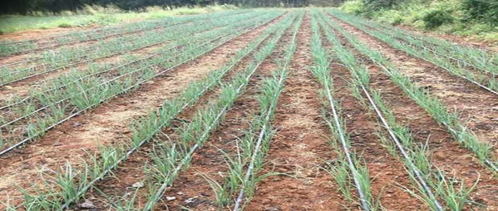
- Onions require light and frequent irrigation.
- Irrigate moderately and timely
- At the growing stage: excessive moisture must be avoided.
- At the bulbing stage: need a substantial amount of water.
- Watering should be reduced/discontinued towards bulb maturity.
- Lighter soils need more frequent water applications, but less water applied per application.
- Increase the water application as plant and roots increase in size.
- Proper moisture management is important in:
-
- Alleviating “Pink Root”.
- General root health.
- Vigorous bulb growth.
- Drought stress will cause splitting or formation of double/ multiple bulbs.
Drip Irrigation System
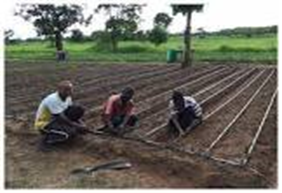
- Fertilizer and nutrient loss are minimized due to a localized application and reduced leaching.
- Water application efficiency is high if managed correctly.
- Field leveling is not necessary.
- Fields with irregular shapes are easily accommodated.
- Keep the fields weeds free. Weeds are potential host of pests and disease and also nutrient competitors for onion plant.
- Proper weed control is very essential for improved quality and quantity produce.
- Weeds in and around the field can harbor insects and disease pathogens that can invade or spread to the crop soon after planting.
Control weed from early stages of onion growth to avoid direct competition for nutrients, water and light.
Power Tiller
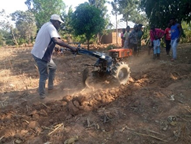
Two- wheeled agricultural implement with attachments.
- Test soils before planting to guide application rates of manure and fertilizer, soil test is recommended for accurate fertilization.
- Onion does well when soils are enriched with organic compost.
- Incorporate well decomposed manure and mix well before planting.
- Avoid applying fresh manure to onions, since it causes death of roots and pests that attack the root system.
- Top-dressing can be done in 2 splits.
-1st Top-dressing: 30 days after transplanting at 40 kg/acre of CAN.
-2nd Top-dressing: 45 days after transplanting at 80 kg/acre of CAN.
- Strip/banding method is preferred over broadcasting as it is more effective.
- Too much nitrogen results in thick necks.
- Top-dressing should be completed before initiation of bulbing.
- Observe the farm regularly during crop production period for pests, disease, weeds and general look of crop health like water and nutrition requirements.
- Practicing conservation tillage is recommended for moisture conservation and to reduce field operations by farm equipment thus reducing soil compaction.
- In disease management crop residues should be removed from the field and destroyed or deeply ploughed in to reduce sources of disease infection and spread.
- Mulch around onions to preserve soil moisture and keep the soil cool in warm weather.
- Unearthing is removal of excess soil around the bulb/loosening soil to allow the bulb to expand or develop well.
- Unearthing can also facilitate the coloring and curing.
- If the soil is hard during bulb formation, loosen the soil to allow bulbs to develop well.
- Unearthing is carried out during 2nd and subsequent weeding and is done by removal of the soil from the bulbs by hand.
- Watch out not to damage or expose the roots.
Pest Management
- Monitor onions regularly for pest and disease occurrence. Early detection of pests and diseases is critical to easier control of outbreaks.
- Weed killers.
- Crop performance materials.
- Pest control chemicals.
Motorized Knapsack sprayer
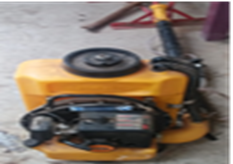
source:Infonet Biovision.org
Onion Thrip

Source: Infonet Biovision.Org
Damage:
- Attacked leaves have sunken silvery patches.
- Under severe attack, the entire plant appears silvery and later the leaves wither, dry up and die.
- The pest excreta appear as black spots on the silvery leaves.
Control
- Keep plants well irrigated since water stressed plants are more susceptible to thrips damage.
- Maintain weed-free plots.
- Rogue heavily infested plants.
- Neem extracts can be sprayed on attacked plants.
- Spray with recommended insecticide.
Onion Fly
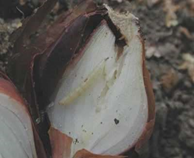
Source: Infonet Biovision.Org
Damage
- They eat the lateral roots causing tunnels into the stem then the plants become shriveled or eventually die.
- They are also found inside developing onion bulbs and their feeding exposes the plant to infection by diseases, such as Bacterial Soft Rot.
Control
- Practice crop rotation.
- Use well decomposed manure/compost.
- Practice field sanitation: remove and destroy infested plants.
- Carefully plough in crop residues immediately after harvest.
Major Diseases
Onion Downey Mildew

Source: Infonet Biovision.Org
Damage
- Formation of lesions near the tips of the older leaves.
- Yellow patches covered with grey wet fields.
- Leaf tips shrink, turn pale brown and later die.
Control
- Crop rotation.
- Field hygiene.
- Use of tolerant varieties e.g.) Red Pinoy F1.
- Use of fungicides e.g.) Mancozeb (Cadilac®, Dithane M45® etc.).
Purple Blotch
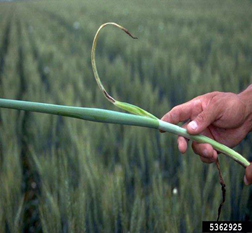
Damage
- Small white spots on the foliage.
- Under moist condition, the spots rapidly increase to large purplish blotches often surrounded by a yellow to orange border.
- Lesions extend to girdle the leaf which leads to its collapse.
- Infection may spread to the bulb, where it may cause a wet, orange rot starting at the neck.
Control
- Use tolerant varieties e.g., Red Passion F1 and Red Pinoy F1.
- Crop rotation.
- Field Sanitation: remove crop remains after harvest, do not leave volunteer plants in the field.
- Avoid over fertilization.
- Recommended spacing and good drainage to decrease humidity in the plant stand.
- Use of fungicides such as Mancozeb (Dithane M45®) Difenoconazole (Domain 25% EC®), Propineb + Cymoxanil (Milraz WP 76®), Eugenol (e.g., Explorer 0.3 SL®).
Onion Rust
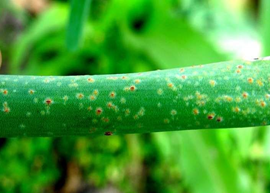
Damage
- Include reddish to dusty orange spots (pustules) on leaves.
- Heavily infected leaves turn yellow and die.
Control
- Application of Good Agronomic Practices i.e., Crop rotation, proper nutrition and spacing.
- Use recommended fungicides.
Pink Root Rot

Damage
- Similar to nutrient deficiencies or stress associated with extremely dry conditions.
- Light pink to yellowish-brown discoloration on roots that becomes dark pink then red and eventually purple.
- In advanced stages roots eventually shrivel, become brittle and die.
Control
- Good management practices that reduce plant stress.
- Crop rotation.
- Use tolerant cultivars e.g.) Red Passion F1.
Neck Rot
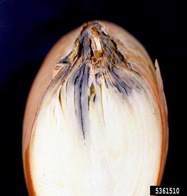
Damage
- Top part of the bulb will turn browner and the skin will be darker brown.
- Top of the bulb will be softer than the lower parts.
- Grey mold and sometimes speckled with small black spots will appear, and the bulbs will deteriorate even further.
Control
- Use fungicide treated seeds or sets.
- Avoid damaging onion bulbs at or during harvest.
- Don't bend over foliage to hasten drying out.
- Only harvest onions when the necks have ripened and fallen over on their own accord.
- Avoid using high nitrogen fertilizers.
- Crop rotation at least 3 years.
- Dry the bulbs out thoroughly after harvest.
- Good ventilation is important in the drying process than sun.
- Store only bulbs with dried out thin necks.
- Store bulbs in a cool and dry place.
- Sort out bulbs which show signs of rot.
- At maturity, leaf tops begin to discolor, bend and dry towards the ground.
- Bulb Onions are mature when 75 % of the tops of the crop have dried and fallen over.
Reduced thickness of sheath leaves surrounding the bulbs.
- Harvesting can be done 90-150 days after transplanting depending on the variety.
- The last three weeks before harvest, the weather should be absolutely rain-free/dry.
- Trim the roots and foliage during harvesting.
In field Curing

- Objective is to prolong shelf life (reduce moisture loss and diseases spread).
- Harvested onions placed in rows with leaves partially covering the bulbs to prevent sunburn or greening.
- Onions are then left in the field until the outer leaves and neck are completely dry.
- Field curing can take 2–3 weeks depending on the environmental conditions.
Out of Field Curing
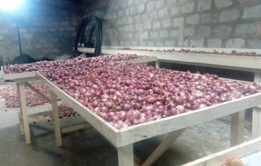
- Removal of excess soil.
- Trimming of foliage leaving 2.5cm of section of stem at neck.
- Placing onions in single layer in large flat tray.
- Onions also cured by tying tops of bulbs in bunches and hanging in well ventilated shade.
Storage
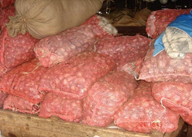
Sorting
Before storage, Bulb Onions are graded to remove the following:
- Onions with thick necks.
- Onions which have bolted.
- Injured onions.
- Decayed onions.
- Forked and small bulbs.
Store/package Bulb Onions in nets to ensure the following;
• Well ventilated structure with shelves.
• Free from dampness.
• Darkness to reduce sprouting.
Dehydreaed Oions
- Dried onion flakes prepared by drying onion slices.
- Onion powder is made by grinding the dried onion slices.
- Solar tunnel dryers and chimney dryers used in drying onion slices.

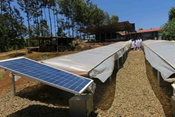
Parkling of Onions
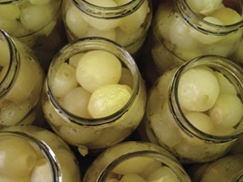
Source: Willis Owino, JKUAT
- Process of preserving / extending the lifespan of onions by either anaerobic fermentation in oils or alcohol.
- Pickling imparts unique characteristics to onions (flavor, texture, and color).
Onion Wine

- Industrial product from fermatation and distillation of onion juice.
- Contains 60-70 % alcohol.
- Stored for 6 months for quality improvement.
- Source for onion market prior to harvesting.
- Onion is easily sold in most local market in the country.
- Farm gate agents.
- Small retailers in small towns.
- Group marketing recommended for better returns.
- Major wholesalers in major mass markets.
- Prices are affected by demand and supply forces.
Basic Costs
1kg of onions at the market price goes for an average of KES 60 hence 60*20,000=KES 1,200,000 less average cost of production which is KSh. 150,000 per Acre = KSh. 1,150,000.
However, the gross margin will largely depend on the variety grown, the level of management employed by the farmer and prevailing market situation.
Further reading
Sakata http://sakata.co.za/project/red-creole-short-day-red-onion/ Source: https://www.kalro.org/sites/default/files/onion-timps.pdf
https://web.facebook.com/easeedmarketing/posts/2660176707411380
Contacts
Kenya Agricultural and Livestock Research Organization
P.O. Box 57811-00200, Nairobi, Kenya
Call: 0111010100